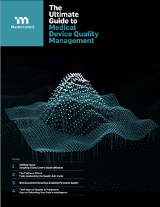
GxP Lifeline
FDA’s New 510(k) Pathway Highlights Safety and Performance Data
The U.S. Food and Drug Administration (FDA) continues to create avenues for life sciences companies to get products approved and on the market at a faster pace — all without compromising its high standards for quality, safety and efficacy. In August 2020, the FDA issued the first two device-specific final guidances under its new safety and performance-based pathway for 510(k) marketing clearance.
The guidances for the new device-specific regulatory pathway specify the safety and performance criteria that sponsors should provide in submission documents. The agency agreed that this pathway could be less burdensome than the processes involved in demonstrating equivalence to a predicate device.1
Motive for Modernizing the 510(k) Pathway
The new 510(k) pathway aligns with other efforts the FDA has made in recent years to bring the life sciences industry in line with modernized approaches and technologies and drive continuous improvement in public health. Some of the agency’s other initiatives include:
- 21st Century Cures Act – Designed to help accelerate medical product development and bring new innovations and advances to patients.2
- Breakthrough Devices Program – Voluntary program for medical devices and device-led combination products for more effective treatment or diagnosis of life-threatening or irreversibly debilitating diseases or conditions.3
- Technology Modernization Action Plan (TMAP) – Established to help bring the life sciences industry and regulatory processes up to speed with the latest technologies in order to expedite breakthrough innovations for improving public health.4
In November 2018, then FDA Commissioner Scott Gottlieb outlined the importance of modernizing the 510(k), stating “Data show that nearly 20% of current 510(k)s are cleared based on a predicate that’s more than 10 years old. That doesn’t mean the products are unsafe. But it does mean that some devices may not be continually improving, which is the hallmark of health technologies.”5
Your Data Is Key to Compliance
When seeking market approval for a new device through the safety and performance-based pathway, your data must show that the new device meets the FDA-defined criteria. If it fails, the FDA would not be able to find that the new device is substantially equivalent through this program.6
That said, the type and quality of the data you use to demonstrate how your device meets the criteria is critical. To be useful, data needs to be comprehensive, high quality and able to undergo robust analytics. Therefore, it’s important that your data management methods:
- Allow integration of data from disparate sources.
- Enable standardization.
- Eliminate biases.
- Ensure data quality and integrity.
FDA Commissioner Stephan Hahn has emphasized the importance of modernized data management practices: “I strongly believe that we need to do everything we can to attain more and better data for the work we’re doing, to be more proactive in gathering data, and to be more creative and thorough in our analysis of it.” Hahn said. “By harnessing this power, we can improve our regulatory decision-making and more effectively connect today’s groundbreaking scientific discoveries with the rapid development and approval of new products.”7
The Value of Modernization
With so much riding on your data, it’s important to have confidence in your data collection, storage and analysis technologies. Because data comes from a variety of sources and in a variety of formats, the perennial issue is the inability to use all the available data to its full potential.
For instance, unstructured data is particularly challenging. It comes from word processing or spreadsheet programs, emails, transcripts, online forms, etc. and is often stored in multiple locations. Much of this data goes unused because it’s not standardized. Manually converting it to a usable format is laborious and prone to errors. Still, businesses are missing out on critical information by leaving this data on the table.
The FDA continues to move forward with its initiatives toward modernization. Out of necessity, companies across the life sciences industry are implementing technologies that will maximize their data and data management processes. Organizations can also benefit from seamlessly integrating predictive analytics, risk intelligence and quality management processes.
References
- “FDA Issues First Final Guidances on New 510(k) Pathway,” WCG FDANews, Aug. 19, 2020. https://www.fdanews.com/articles/
- “21st Century Cures Act: Implementation Update,” Thomas Sullivan, Policy and Medicine, Feb. 17, 2019. https://www.policymed.com/2019/02/21st-century-cures-act-implementation-update.html.
- “Breakthrough Devices Program,” U.S. Food and Drug Administration. https://www.fda.gov/medical-devices/how-study-and-market-your-device/breakthrough-devices-program.
- “FDA’s Technology Modernization Action Plan (TMAP),” Sep. 18, 2019. https://www.fda.gov/media/130883/download.
- Statement From FDA Commissioner Scott Gottlieb and Jeff Shuren, Director of the Center for Devices and Radiological Health, on Transformative New Steps to Modernize FDA’s 510(k) Program to Advance the Review of the Safety and Effectiveness of Medical Devices,” FDA Statement, Nov. 26, 2018, U.S. Food and Drug Administration. https://www.fda.gov/news-events/press-announcements/statement-fda-commissioner-scott-gottlieb-md-and-jeff-shuren-md-director-center-devices-and.
- “Safety and Performance-Based Pathway: Guidance for Industry and Food and Drug Administration, Sept. 20, 2019. https://www.fda.gov/media/112691/download.
- “FDA’s New Chief Stresses Data, Consumer Empowerment and Innovation,” Nancy Crotti, Medical Design and Outsourcing, Jan. 31, 2020. https://www.medicaldesignandoutsourcing.com/hahn-outlines-goals-for-fda/.
Free Resource

Enjoying this blog? Learn More.
The Ultimate Guide to Medical Device Quality Management
Download Now